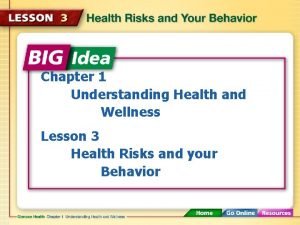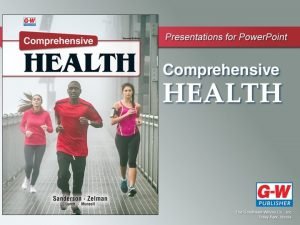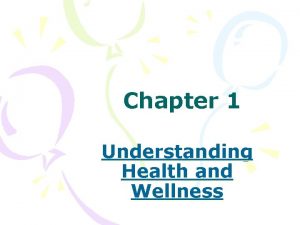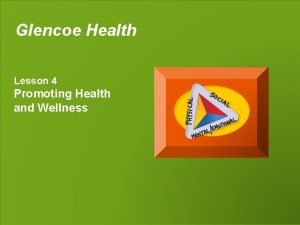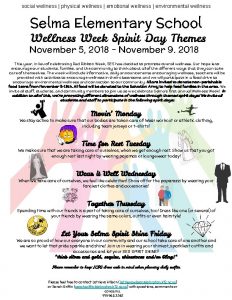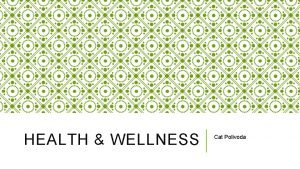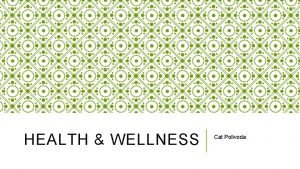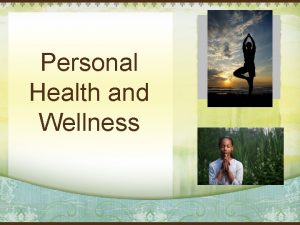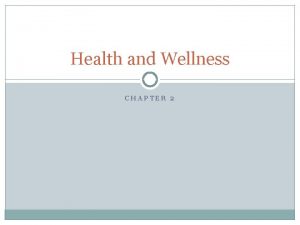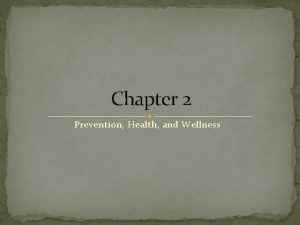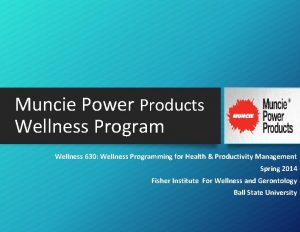CHAPTER 1 UNDERSTANDING HEALTH WELLNESS LESSON 1 YOUR












- Slides: 12

CHAPTER 1 UNDERSTANDING HEALTH & WELLNESS

LESSON 1 : YOUR HEALTH AND YOU Take Charge of your Health - You are responsible for your own health. Your Health Triangle It’s important to balance your physical, mental/emotional, and social health. When you are in good health, you have the energy to enjoy life and pursue your dreams. The three areas of health include physical health, mental/emotional health and social health.

Physical Health – Physical health is all about how well your body functions. Having a high level of physical health means having enough energy to perform your daily activities, deal with everyday stresses, and avoid injuries. Five important actions you can take to keep a healthy body are Get eight to ten hours of sleep each night Eat nutritious meals and drink eight cups of water each day Engage in 30 to 60 minutes of physical activity each day Avoid the use of alcohol, tobacco and other drugs Bathe daily, and floss and brush your teeth every day

Mental/Emotional Health – Mental/emotional health is about your feelings and thoughts. It is a reflection of how you feel about yourself. People who feel mentally and emotionally healthy Enjoy challenges that help them grow Accept responsibility for their actions Have a sense of control over their lives Can express their emotions in appropriate ways Usually can deal with life’s stresses and frustrations Generally have a positive outlook Make thoughtful and responsible decisions Spiritual Health – Mental health also includes spiritual health, a deep seeded sense of meaning and purpose in life.

Social Health – Getting along with others, also known as social health, is as important to your overall health and wellness as having a fit body and mind. Keeping a Balance - when your health triangle is balanced, you have a high degree of wellness, an overall state of well being or total health

The Health Continuum Your health and wellness are always changing. For instance, you may feel great one day and catch a cold the next. Your health at any moment can be seen as a point along a continuum, or sliding scale. The continuum spans the complete range of health, from a loss of health and wellness at one end to high level wellness at the other. As you mature, your position on the continuum continues to change. Many Americans, unfortunately, start moving toward the lower end of the continuum. One half of all American adults live with a chronic disease, an ongoing condition or illness such as heart disease, obesity, and cancer.

LESSON 2 : WHAT AFFECTS YOUR HEALTH Heredity, environment, attitude, behavior, media, and technology can all influence your health. Heredity – Your heredity refers to all the traits that were biologically passed on to you from your parents. Environment – Your environment is the sum of your surroundings, including the physical places in which you live and the people who make up your world. Physical environment – some environmental factors that can affect your health include Neighborhood and school safety Air and water quality Availability of parks, recreational facilities, and libraries Access to medical care Social environment – your social environment is made up of all the people around you, including your family and peers. Your peers, people of the same age who share similar interests, also include your friends. Culture – Culture refers to the collective beliefs, customs, and behaviors of a group. This group may be an ethnic group, a community, a nation, or a specific part of the world.

Attitude – Your attitude, or the way you view situations, can have a big effect on your health. If you believe that adopting healthful habits will influence your health in positive ways, then you are more likely to make the decision to practice them. Behavior – You have total control over your own behaviors. You can choose to avoid high risk behaviors in favor of healthful behaviors. Media and Technology – Every day you encounter one of the most powerful influences on your health – the media. Media are the various methods for communicating information. This content is delivered via technology, such as radio, television, and the internet, and through print media, like newspapers and magazines. The constant presence of media messages has a significant influence on your decisions.

LESSON 3: HEALTH RISKS AND YOUR BEHAVIOR Risk Behaviors are actions that can potentially threaten your health or the health of others. Recognizing Risk Behaviors – the Center for Disease Control and Prevention (CDC) has identified six risk behaviors that account for most of the deaths and disability among young people under age 24. Tobacco use Unhealthy dietary behaviors Inadequate physical activity Alcohol and other drug use Sexual behaviors that may result in HIV infection, other sexually transmitted diseases, and pregnancies Behaviors that contribute to unintentional injuries and violence Cumulative Risks – related risks that increase an effect with each added risk. Abstinence - a deliberate decision to avoid high risk behaviors, including sexual activity and the use of tobacco, alcohol and other drugs.

Lifestyle Factors – the personal habits or behaviors related to the way a person lives. Lifestyle factors that can improve a person’s level of health include Getting eight hours of sleep each night Starting each day with a healthy breakfast Eating a variety of nutritious food each day Being physically active for 30 to 60 minutes most days of the week Maintaining a healthy weight Abstaining from smoking or using other tobacco products Abstaining from the use of alcohol and other drugs

LESSON 4: PROMOTING HEALTH AND WELLNESS The Importance of Health Education Individual, family, community, and national health require planning and responsible behavior on everyone’s part. Today, America spends $2. 3 trillion each year on healthcare, or $7, 600 person. Much of that expense could be avoided if people made healthier decisions about the way they live, adopted health promoting habits, and took responsibility for maintaining their wellness. Health education includes providing accurate health information and teaching health skills to make healthy decisions.

Healthy People - a nationwide health promotion and disease prevention plan designed to serve as a guide for improving the health of all people in the United States. Goals of Healthy People (Established in 2010) with two general goals for the future: Increase the quality and length of a healthy life for all Americans. Remove differences in health outcomes that result from factors such as gender, race, education, disability and location. Becoming Health Literate – to become an informed individual who can make sound health decisions, one must Know where to find health information Decide if the information is correct Assess the risks and benefits of treatment Figure out how much medicine to take Understand test results Health Literacy – refers to a person’s capacity to learn about and understand basic health information and services, and to use these resources to promote one’s health and wellness.
 Chapter 1 lesson 2 what affects your health
Chapter 1 lesson 2 what affects your health Chapter 1 understanding health and wellness
Chapter 1 understanding health and wellness Chapter 1 understanding health and wellness lesson 4
Chapter 1 understanding health and wellness lesson 4 Chapter 1 understanding health and wellness lesson 2
Chapter 1 understanding health and wellness lesson 2 Chapter 1 understanding health and wellness lesson 3
Chapter 1 understanding health and wellness lesson 3 Understanding your health and wellness chapter 1
Understanding your health and wellness chapter 1 Chapter 1 understanding health and wellness answer key
Chapter 1 understanding health and wellness answer key Chapter 1 understanding your health and wellness
Chapter 1 understanding your health and wellness Understanding health and wellness
Understanding health and wellness Chapter 3 health wellness and health disparities
Chapter 3 health wellness and health disparities Glencoe health and wellness
Glencoe health and wellness Chapter 1 lesson 4 promoting health and wellness
Chapter 1 lesson 4 promoting health and wellness Lesson 1 your total health
Lesson 1 your total health




